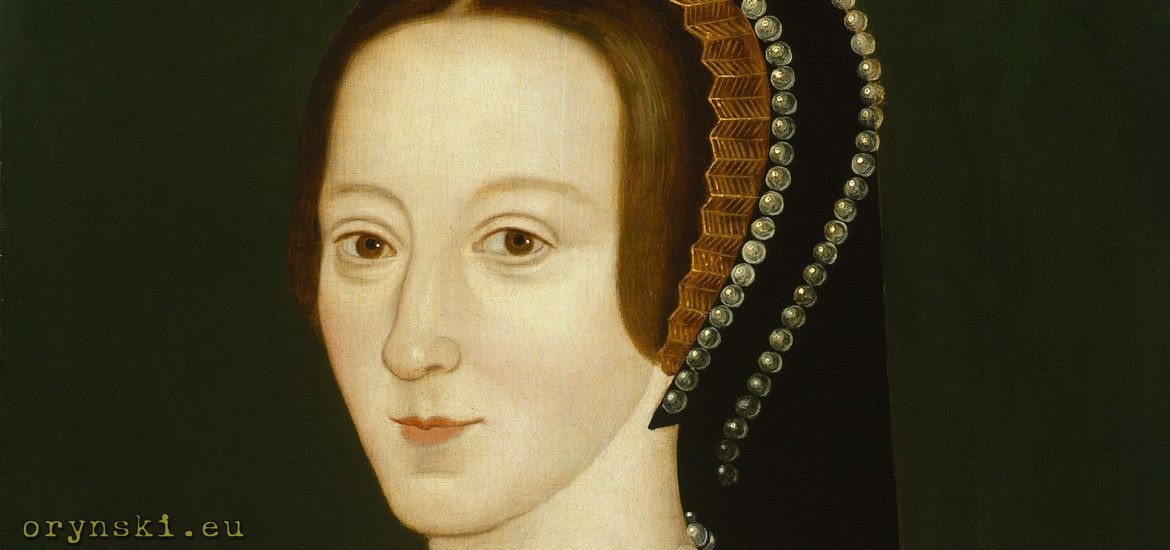Gazeta Wyborcza, the biggest Polish daily paper, decided to gain some clicky by resurrecting a discussion that tumbled across the Polish internet a couple of weeks ago. The question of casting Jodie Turner-Smith, a black actress, as Ann Boylen in the oncoming Netflix series was controversial. Since the series was announced as a period drama, some potential viewers expressed their criticism – period drama, by definition, should aim to portray the historic background close to reality, or at least to how we imagine that era, based on our historical knowledge. Ann Boylen was a real person, and while we might not know as much about her as we would like, we can be pretty sure that she wasn’t black. Of course – it is possible that this is well thought casting decision – I saw rumours, that casting a black actress as Ann Boylen is a tool to show how estranges she was at the court. But as a rule, the concept of the drama period is to portray – visually, as cinema is a visual art – the period and its characters as trustworthy as possible. But if you share that opinion – be wary, as you might be called racist. Or at least a hypocrite, because “where you were back in the 1980’s, when a Polish, white actor played a Chinese character in a children movie?” – asks a popular Polish writer Jacek Dehnel in his essay in Gazeta Wyborcza.
I think every one of us at least once participated in a discussion about if said actor or actress playing some historical – or at least well established in culture – the character was cast well or not. We all spoke, or heard, words like “This acrtess looked just like that person she played!” or “This actor was nothing how the person looked, he was not believable in that role”. I guess nobody would even give a second thought and try to assign some deeply cultural background to such discourse. At least until now, when a black actress is considered by many to be cast wrong in the role of Ann Boylen. At this moment, the preachers of progress like Jacek Dehnel step in and try to go to lengths to prove, that the only reason why someone could say things like that is racist – either pure, straight racism, or an unconscious one, resulting from our cultural upbringing.
In his essay, Denhel starts by invoking several examples of Polish actors playing people of colour in old movies. I will have mercy to ignore that bit, as everyone who knows a thing about Poland under communist rule knows, that there was not exactly a wide choice of actors of colours speaking fluent Polish available at this time. Still, it’s worth to observing that they played those roles with a special effect makeup to make them look like the people of the other races, it was not used to show that a proud, white man, can do everything, as Dehnel seems to be suggesting.
Next Dehnel mentions several theatre plays saying universal stories, saying that in theatre is nothing unusual to men play women, women play men and so on. Somehow this is supposed to be proof that while a white man can play everything, a black woman cannot. This is, in principle, not true, although the discrimination of black actors and actresses and a smaller number of roles available to them due to racist bias in Hollywood and cultural background is a fact.
Then the writer turns to lecture the reader about how contractual the art is, and that the story told will never be a perfect representation of the reality – and of course he is right again. He brings many examples of historical inaccuracies in classic pieces of art and asks “Why we can tolerate historical inaccuracies when we see an understandable artistic concept that led to it, but can’t tolerate black Ann Boylen?”. The answer is simple, really: if a black Ann Boylen is an understandable artistic concept, then we’ll of course tolerate it being historical inaccuracy. But if the only reason is colourblind casting, or, for example, Jodie Turner-Smith’s skin colour is simply used to generate publicity, or she has been given a role so some “inclusivity supervisor” can tick a box to confirm, that people of all races were included in creating that movie, and so the black actress is going to play English queen against the rules of the genre, while everything else will be kept in the period-related realities, then the criticism might be valid – because the internal cohesion of the period drama genre will be disrupted.
In the following paragraph, Dehnel asks “why we have accepted black and white movies if we know that the world is colourful, or why we don’t complain about one male lector dubbing all the voices in the TV movie” (which is still a popular practice in some Eastern European countries). Well, we accepted it, because it was caused by technological or financial limitations and today only rarely movies are shot in black and white – and then it is always an artistic choice. Then Dehnel asks the most absurd analogy: if the white characters are to be played by actors who are white themselves, then surely aristocratic characters could only be played by actors who are aristocrats themselves. “Black Ann Boylen only causes dissonance, because we are not used to black actors being allowed to play all roles. Why can’t we get used to it, if we accept that a daughter of a seamstress can play a queen? The answer is simple, but not pleasant” – he writes.
The answer is simple indeed. We are not able to tell just from looking at the person, if she is a daughter of a seamstress, or if she is a princess. But we are able to tell straight away when the person is black or white (although, of course, this is a spectrum and might not be so easy for the people of mixed race). So while a white daughter of a seamstress can put a queen’s dress and a crown and look convincing as an English queen, a black actress won’t be convincing as a (historical) English queen, unless she is made to look white-skinned by special effects make up. It’s not because being black is somehow worse. It is because, at least so far, English queens tend to be white. And can that answer be not pleasant? To Jacek Dehnel – perhaps – yes, as he seems to be pretty comfortable in his role of an enlightened man lecturing his stupid, backward countrymates. He seems also to be well fixated on his idea that one can tell if your ancestors were aristocrats or peasants just from looking at you (although he refused to explain how he does it to the people, who asked him about that on Facebook).
Next, he argues, that the nation is just a concept and that while for us, Poles, a homogenous society feels natural, the British society, thanks to the history of the British Empire, is by definition multicultural. And that Shakespeare is as much a part of the culture of a white English man, as of that of black descent. He’s right as well. They share culture, and they share history. But the history of the British Empire is, that while white people were enjoying their privileged lives, sometimes leading a luxury life at kings court, the ancestors of those who have a bit darker skins were most likely working hard to enrich those white Englishman, often as slaves.
Finally, Dehnel quotes someone, who asked if it would be OK for a white actor to play Nelson Mandela, or for a black actor to play Hitler, but refuses to answer it, instead suggesting that those, who need explaining such things are ignorant, and thus beyond any help. He finishes with, otherwise valid, statement, that the word is changing and today people fo various ethnical backgrounds mix with each other, so we cannot really talk about separate races, as we used to talk when people of different colours led completely separate lives, divided by thousands of miles or at least by the lines of the social divide. And he is right again. But in all of that lengthy essay, he failed to explain why criticizing the choice of a black actress to play a white historical character in a setting where historically black people had no right to be can cause dissonance to a viewer.
* * *
Between the lines of Dehnel’s essay a simple message can be visible: a black actress has as much right to play any role she wants as the white one, and if someone dares to say a white actress would be better for some role, then he’s racist. And one can agree with that in principle, black actors should not be discriminated against. But as with every rule, there might be exceptions, where taking the actor’s skin colours in consideration while casting is not the case of racism.
One of such exceptions can be a genre of drama period, historical, or biographical movie, where the creators aim to create a believable picture of the era and the characters in question. That, for visual art like cinema, means in a huge part a visual representation. Mind you “believable” does not necessarily mean “100% historically accurate”. When I entered the discussion at Jacek Dehnel’s Facebook profile, his fans asked me mockingly “but do you know that NO actress will look perfectly like Ann Boylen” or were pointing some other historical accuracies in other movies. But they miss the point: we don’t need 100% accuracy. We need a sufficiently good approximation to make it believable.
Let’s imagine a movie scene: a detachment of soldiers leaves their hometown to join their brothers in arms in the trenches of World War 1. Their girlfriends are in tears, last kisses on the platforms, and they are ordered to get on board the train. The steam engine whistles, and with the great rumble the train leaves the platform, leaving the girls, the clouds of black smoke and white steam behind. A moving scene. And would most people be bothered if the locomotive used in the movie was manufactured in 1922 and the cars were even younger? If the girls on the platform were wearing dresses tailored in the way that came to the fashion only five years after the action supposedly took place? Unless they are some train or historic fashion nerds – probably not.
But now imagine the same scene. The soldiers wave their goodbyes and then stand in the row, to enter the shiny TGV train through the narrow dors. They place themselves in the windows, that don’t open, and send kisses to their girlfriends, who wear wet look leggings and dr Martens shoes, while their train leaves the platform in silence, broken only by a quiet hum of its electric engine. Even someone with absolutely no knowledge of the XX century would be able to notice that something was not right in that scene, right? While this could work in the certain convention of an ahistoric movie, in a typical period drama that would be considered a big mistake, grossly spoiling the immersive experience…
The presence of black people at the court of Henry VII is a similar ahistoricism. Of course, Jacek Dehnel et al. can argue on Facebook (and they actually do that) that, theoretically, there COULD be black women at the English court in that era. And that black-skinned aristocrats existed. But even if we agree with them that this is likely, then still, we have enough historical data to be pretty sure that Ann Boylen was NOT one of them. So if we want for her character to look believable in a typical drama period, the actress who played her also needs to be white – or at least made look white by the makeup artists.
But, of course, the drama period is an exceptional case. I am as far from behind from making excuses for the people outraged that in the Netflix adaptation of “The Witcher” the elves were played by black actors. “Nobody ever saw black elves” they cry, but it’s utterly stupid. Nobody even saw a white elf either, or the green one covered with pink polka dots for that matter. I have also nothing against movies that break the rules of the genre. About the movies, they tell a universal story in new settings. Some say, for example, that Patrick Stewart’s greatest contribution to Start Trek (apart from his great acting worthy of the actor of one of the best theatres in the UK) was introducing Shakespearian motives into several episodes of The New Generation. We might also remember a famous adaptation of Romeo and Juliet set in the costume of gang wars:
But the concept must be coherent. If the concept is to create a believable picture of the era, then a black character in the place when – at the time – black man had no right to be will be as big dissonance as if we would dress one of the characters from the movie taking places centuries ago in jeans and trainers, or a space suit of a Soviet cosmonaut. Because no matter how politically correct and anti-racist are we, there are situations when the physical appearance of an actor is important. For example for the vast majority of the roles, the size of the actor’s nose is irrelevant. But its a key element in the story of Cyrano de Bergerac, so no matter if we watch Gerard Depardieu in a period drama style adaptation, or Roxane, Steve Martin’s modern take on that story, then the actor playing the main character has either to already have a huge nose or be made to wear one. Of course, it would be possible to use different ways to tell that story, and every story can be told in a way where the physical appearance of an actor – such as skin colour, looks, fitness, age or even sex will be completely irrelevant. But if we want to tell a story in a classic way, and the skin colour of the character is important, then that might limit actors considered for that role to a certain skin colours only. Say, we are to shoot a movie. It tells a story of a lawyer who defends an unfairly accused man. In such a movie might be completely irrelevant if the lawyer was white and his defendant black, or the other way around. But if we want to shoot THE story of a lawyer who defends an unfairly accused man, and that story would be a classic adaptation of “To kill a mockingbird”, then if we cast black actors to play Atticus Finch and his kids, then the story will be completely distorted – unless we use another vehicle than the race to explain to the viewer why some of the inhabitants of the town are considered to be second class citizens. So if someone says: “To Kill a Mockingbird would be a much worse movie if Gregory Peck was replaced by a black actor but everything else stayed the same” – is it racist? I don’t think so.
And so in my opinion is not racist to say “Assuming that new Netflix drama about Ann Boylen aims to paint a believable historical picture of the era, casting a black actress to play the Queen of England might not be the best idea”. For some, though, the criticism of casting a black actress is, indeed, a racial problem: for those, who attack the critics. People like Dehnel, who defend that decision – without seeing a movie either – go to such lengths to prove that those, who don’t like that decision are racist. Jacek Dehnel himself pointed me to another example: a different period drama about Tudors was criticised for that obese king was played by a fit actor. I don’t know if Dehnel approves that decision or don’t agree with it, but somehow I never saw anyone trying to prove that if you didn’t like it, you are a hater who wants to discriminate against slim people…
As I said, none of us seen the movie yet. We don’t know what was the director’s idea. We can only speculate, based on the sparse information, from which one could assume, that it is going to be a period drama. From what I saw so far everything, apart from the colour of the skin of Ann Boylen, will hold to the convention of a classical period drama, at least visually. Some say that casting Turner-Smith in that role might be a symbolic way to show how different Ann Boylen was to everyone else around her. Others say that this is just a way that Netflix tries to show its inclusiveness – by giving more roles to black actors. Some others point out, that if Netflix was really about inclusivity and promoting black culture, instead of casting black actors in yet another drama about the fate of white English upper classes, it would produce some interesting drama with strong black characters instead.
But some just suspect, that it was all a publicity stunt – and this controversial casting surely provided Netflix with loads of free publicity.
Portrait of Ann Boylen: author unknown, public domain





